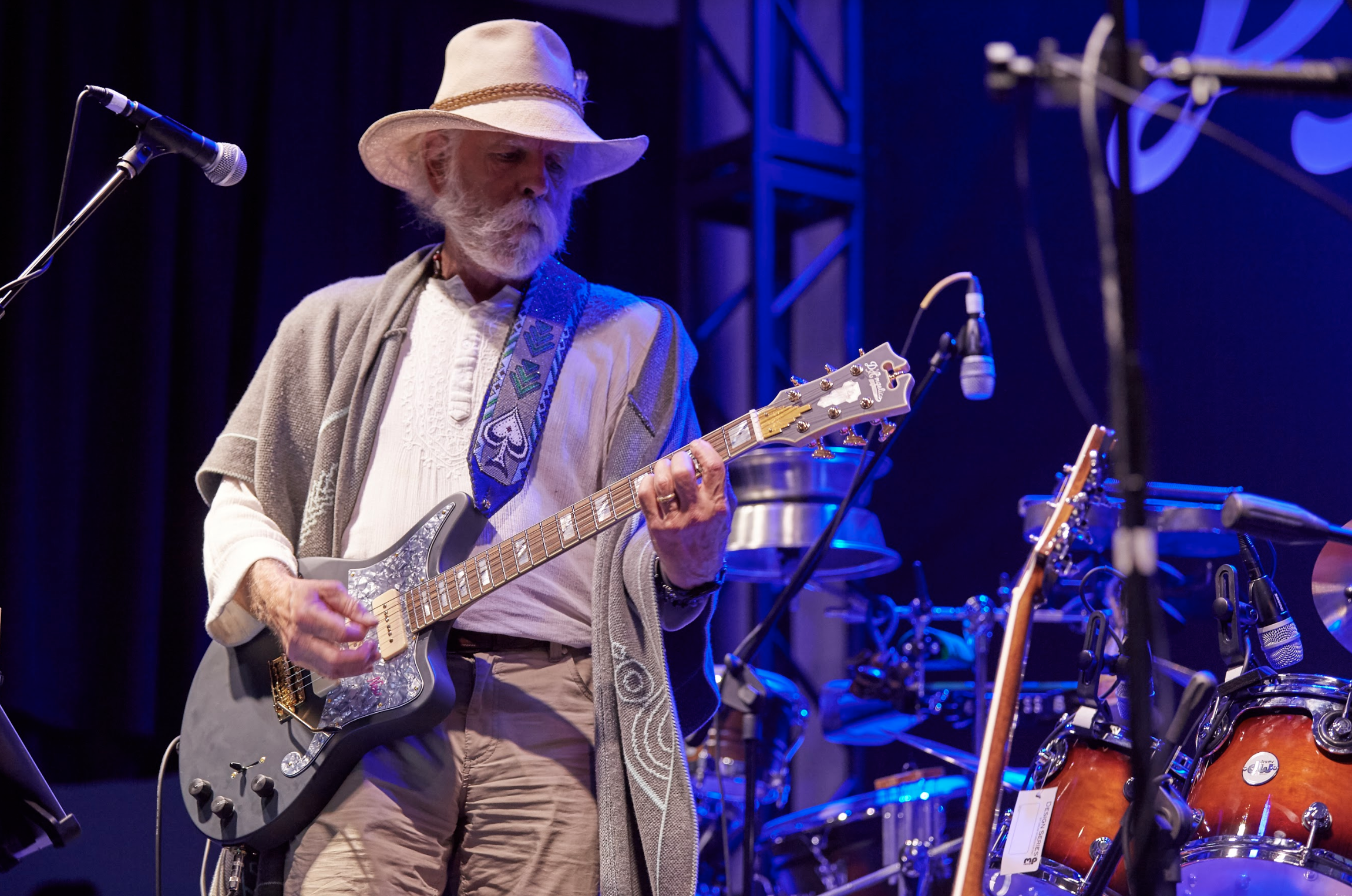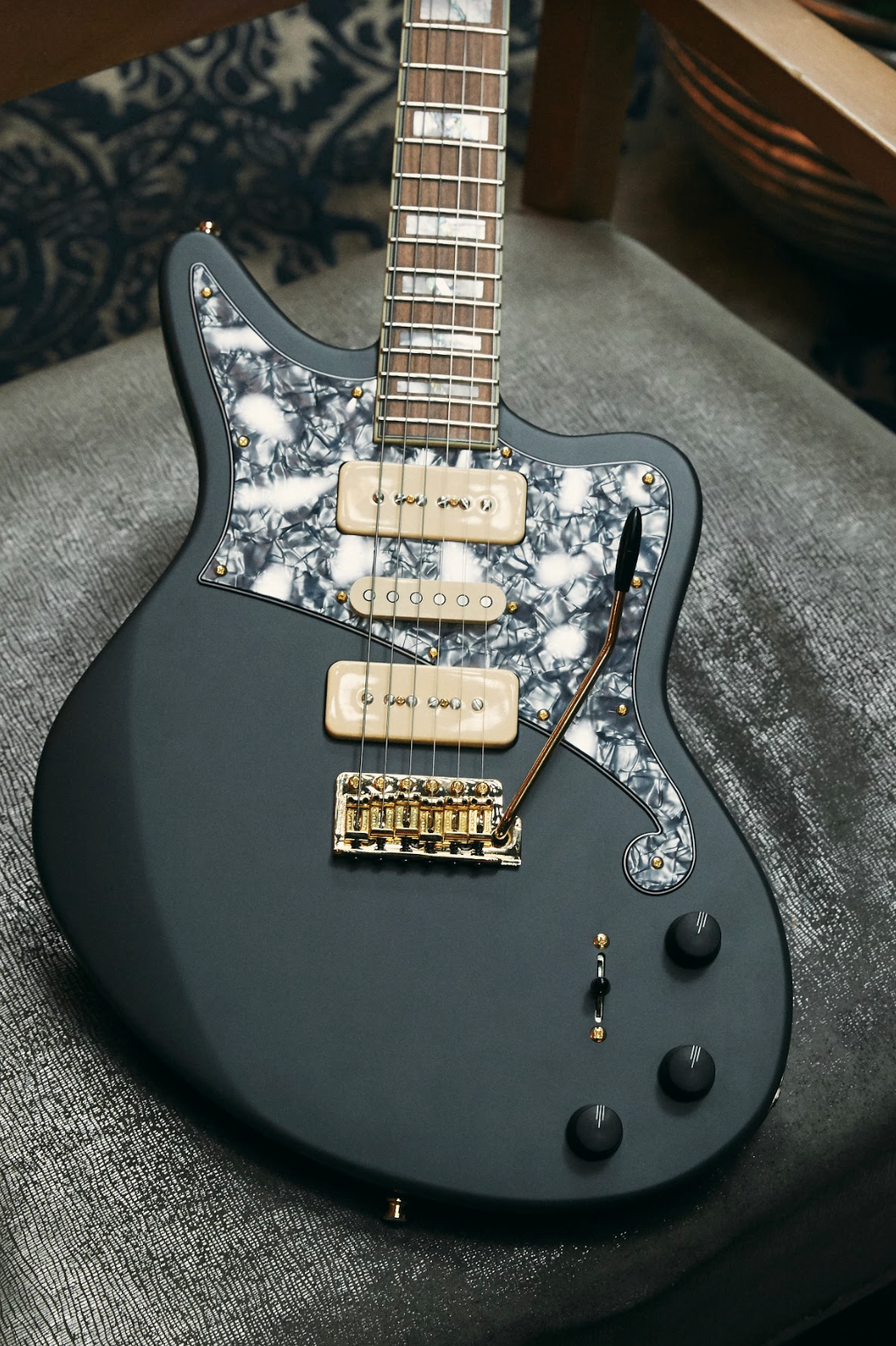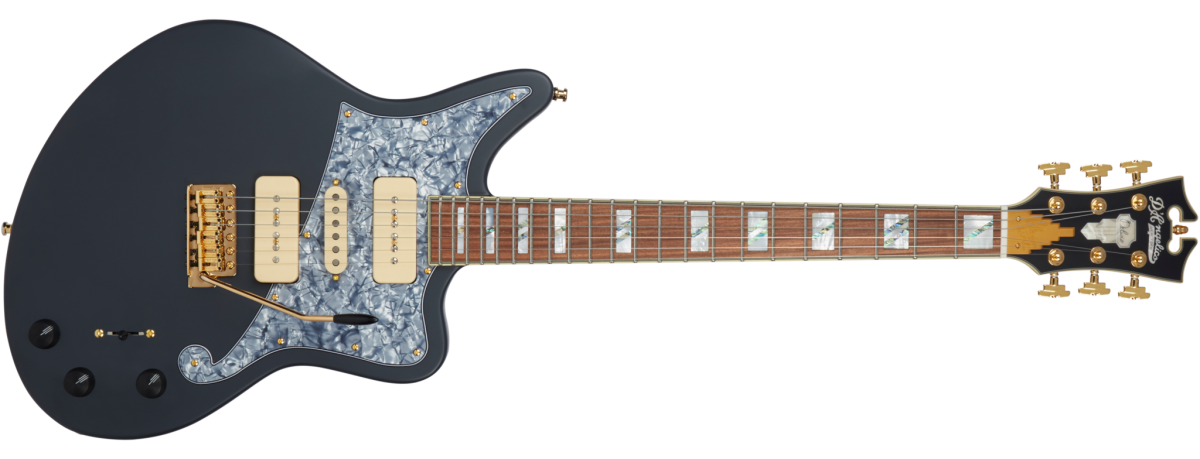Dead & Company's Bob Weir on the Merits of "Listening to Your Guitar"
In this particular case, he's talking about D'Angelico Guitars' New Deluxe Bob Weir Bedford Model

On an overcast Tuesday evening in March, Bob Weir and I settled into a few balcony seats at the Manhattan Center Ballroom in New York City to talk about our latest co-design, the new Deluxe Bob Weir Bedford model, which had debuted three months prior at the 2019 Winter NAMM show, and two years after our first project, the Deluxe Bob Weir SS.
Bob had come straight from another shoot — an in-depth interview and portrait session with GQ. He sat down, slipped off his Birkenstocks and cracked a Yerba Mate, seemingly relieved to now have the chance to talk solely about his greatest love and lifelong pursuit, the guitar.
What has a lifetime of performance on the guitar taught you about the instrument itself?
If there’s anything my instrument has taught me to do over the years, it’s to listen to the instrument. The more I listen, the more it tells me what I want to be doing. It seems to me if you go into playing something with a notion of how it's supposed to sound, you might get there — you might get it how you thought it was supposed to sound. But if you listen to the instrument, you often times are going to find way more spectacular stuff. The instrument will tell you what it wants to be. What it wants to have done with it.
So that sounds more like a conversation with the instrument rather than using it as a tool.
Right. I just take my orders.
I think there’s a tendency for a lot of masters of the craft, like yourself, to know exactly what they want out of the instrument because they have such a defined sound. They tend not to change it. You have an incredibly identifiable sound, but I also know you to be someone who is constantly changing and evolving. Do you think that's due to your listening to the instrument?
All the latest guitar news, interviews, lessons, reviews, deals and more, direct to your inbox!
Yeah. The more I listen to the instrument, the more it tells me, “Okay. The next time you design me, for instance, let's try a different winding on the pickups so that I can get a little more high end. Because you're playing these heavy strings, and the overtone series is shading a little sharp, which gives the sound the unmistakable clang of steel, and let’s lean into that for a bit — turn up the treble.” Like I say, I just take my orders from the instrument.
You've probably logged more hours onstage than any living musician, including more than 3,000 shows with the Grateful Dead alone. Has live performance particularly impacted that listening for you? And if so, how?
That’s an interesting question. Over the years, I've learned to sort of step aside and let the characters in the songs tell their stories. And along with that, they seem to call for certain sounds or soundscapes to accompany them, so that they sort of fill out the coloration. And oftentimes, that'll tell me what kind of sound I'm looking for.
And then, at the same time, if I'm playing and it's time for me to step out or something like that — I'll just sometimes switch pickups to something I wouldn't have thought of. Just to see what that pickup has to say about the story that's going on. And when that works, it's really, really interesting. When it doesn't work — you know, you’d rather be anywhere on Earth than there. But you live through that stuff, too.
So you kind of give the instrument autonomy — that’s interesting. Because I know you demand a fair bit of control over the on-stage sound, but it sounds like you still want to give the instrument the opportunity to speak, independent of you.
Surprise me! It’s nice to do that because the different pickups are sampling the strings in different places, so the overtone series is going to be different. The girth of the note is going to be different. All that kind of stuff. You can play the same thing, but it's going to have certain harmonics ringing, and that's going to take you in this direction or that direction and take you up the neck or down the neck.
In regards to the storytelling you were referencing earlier — often your sets and songs have these very long arcs to them. You'll leave a song and come back to it much, much later. And the same goes for your playing style. When you first hear it, you can’t quite grasp it. But when you dig in, you can hear that you’re crafting a much longer story than was previously apparent, and it helps illustrate the larger motion of the set. Do you think making room for both your voice and your instrument’s voice is what creates such a long arc?
Given that there's a big arc that we're describing with our story and leaving a little of it to chance... If I discover something early on that seems like it might be potentially kind of thematic, I'll bring that back sometimes just to see what that little theme has to say under this light, under this part of the storytelling, and that kind of tightens the story up a little bit. It gives it believability, if you can follow me there. It’s also fun.
Right. So it's something less manufactured.
Yeah!
So for your new signature model — do you think part of the intention behind the new Bedford was making sure that it had the room to create some magic?
That's the whole idea! The more different sounds you can get out of that one instrument — it's a matter of learning what skills that instrument is housing and learning where to go to get them, but really the more different kinds of sounds that the instrument has, the more colors you have on your palette, and that's what you're looking for when you're painting.
How did you specifically identify a need for a guitar like this one?
Well, I was playing with Dead and Company, and the on-stage volume was kind of loud. My original signature model — the semi-hollow — was doing half the job perfectly, but it occurred to me that, okay, maybe it's time to develop a solid body to complete the picture. So we got to work on a solid body and it's been a lot of joy of discovery — we’re just scratching the surface. What we can get from this particular kind of instrument has been a lot of fun, and continues to be.
What do you think the Bedford offers that nothing else you have offers?
Well, the new Bedford can get really bright, and I like that because when you're playing chordal stuff, the harmonic structure of the melody you’re describing is in there. You're ringing a certain number of lofty bells, if you will, with the harmonic structure that you develop through your chordal stuff. Then those become, once again, the colors on your palette. Those are the notes that you're gonna be using, giving you more choices for your melodies. That's what we're getting from this instrument.

In regards to that responsiveness — if you pack enough tonal options into the design, you're creating an opportunity to multiply the effect of applying different techniques to the instrument. Is that versatility something that you were really hoping to establish?
Designing a semi-hollow guitar that has acoustical resonance is going to necessarily limit what kind of tonal variety you can get out of it. Its body resonance is going to be everywhere — all the pickups are going to hear it because it's fed back into the string. With a solid body instrument, those resonances aren't there. And so the actual variety of tonal responses you get from the various pickups and in approaches to getting sound out of your strings is wider. It doesn't have quite the woody charm of a semi-hollow instrument, but the trade-off there is you just get more stuff and more places to go. It's going to be years before I really think that I've got a handle on this instrument.
Is part of the intention designing an instrument that is worth the challenge of learning?
I mean, that's the whole deal. What we're trying to design is an instrument that's going to keep me amused and flabbergasted for years to come so that I've got stuff to work on. You know — “Oh, here's a new sound. Holy Jesus. How are we going to use that? I'm just going to have to sleep on it for a while.” And it'll come back around and sooner or later I'll find a use for it.
And when you're not sleeping on it, you're waking up in the middle of the night thinking about it.
Yep!
You played a show at our NAMM booth this past January, and you had an experience with that specific Bedford that was powerful enough to make you request that exact one. Even if it's the same model, made at the exact same time, etc., do you believe in the black magic of each individual instrument? What is that bond that you feel with an instrument when something just works?
Well, you know, in that particular case, that Bedford was bright and broad and it was exactly what I was looking for. We designed the pickups and had them wound to be bright. Not very hot, but very bright, and you just drop the gain a little bit. Eventually you develop an ability to have a variety of colors — you know, this note wants to be muted, this one wants to be full-spectrum loud, this one we can lean into the harmonics, this one wants to be muted again, etc. You can do all that with this. You know, it takes a little bit of work and a little bit of practice, and you have to love what you're doing, because otherwise it will be confounding. But that challenge was what we were going for with the new Bedford, and by God we're getting there.
More emotionally, the guitar is telling me stuff that I didn't know about the notes that I play. If you play it right, it's going to take you somewhere else. It's going to lead you somewhere else. It's going to lead to this figure or this color, but I know that if I stick with it for a while I'm going to grow on my own — knowing that if I just sit with the instrument for a while, I’m going to grow. It is going to stretch my soul. That's what it's about.

So if the Bedford is enough to keep you flabbergasted and challenged, what do you hope it does for other players?
I would hope that folks who play this instrument are going to find it as challenging and as engaging as I do, because we've tried to design an instrument that's really got a huge variety of sounds, and of course that means it’s going to take a while to learn what it does for you and with your hands — because everybody is going to have a different touch and what they pull out of it is going to be very different. But you know, I just hope it keeps you amused and it keeps you moving forward. Discovering new harmonic or textural possibilities. The whole idea is to create an instrument that's really dynamic and flexible.
Last time we spoke, you had told me about a personification of tone that came up in the studio a long while ago, where someone referred to a guitar sounding like a porcupine blowing kisses. I’m curious whether you’ve come up with a personification for the new Bedford.
Right, that was when we were recording “Tennessee Jed.” We were playing and my bass player took a big hit of pot and then he leaned over to me and says your guitar sounds like a porcupine blowing kisses — it was kind of spiky in the tone. I’m getting way spikier tones now with the Bedford. But I don't smoke that much pot, so those kinds of personifications don't occur to me all that often.
But you know when you get a tone that's going to be a signature tone for a given song — thematic for a given song. It adds character to the story that you're telling. And like I say, it fills out the colors of the story. You know, if you're painting the sky, you might get a deeper blue than real life has to offer. That's the kind of stuff that we're looking to be able to do with the sound. You're painting a picture that couldn't be painted visually, but you can do it with sound because you can go places sonically that are impossible with any sort of visual.
That's like adding to the adage of music accesses what’s beyond words. Music accesses what’s beyond visuals, too.
Bob picks up the Bedford and begins playing.
What are you responding to and what are you listening for?
I'm listening to the higher order in the harmonic series because that tells me where I want to go. And then something that just recently happened to me that may change a whole lot of stuff... if I can get a collection of these. Somebody gave me a stone pick. It's made out of Montana agate, and it puts a little tip on the note. If I use that, and I finger pick a note, then they blend together into something that's a third entity. Hard to describe because there is no name for it.
Bob goes quiet and continues playing the guitar.
Could you describe the electronic configuration that creates all the versatility?
So on the new Bedford, we have a five-way switch, volume and tone knobs, and then a blender knob, which blends in the odd-man-out pickup — the one that isn’t naturally a part of the position you’ve selected. You can just play a note, and roll the blender knob off, and it'll change color because it will be bringing in the odd-man-out.
For example, on position 2 — which is the bridge and middle pickup — if you roll off the blender knob, you’ll bring in some of the neck pickup, as well. Which is, you know, a very different sound — much thicker, much more low end so the harmonic content is going to be real rich. Once you play it, you get a feel for it.
For the pickups, you get the Seymour Duncan Stacked P-90s in the neck and bridge positions. And then you get to blend those with the middle pickup—that Lollar Blonde that’s brighter than a thousand suns, which helps you step out when you need to. There's no end to places you can go with this guitar.
And what about the volume and tone knobs?
Right. They’re push/pull. The volume knob is for the neck pickup, and the tone knob is for the bridge pickup. So in the “pull” position, they are standard single-coil P-90’s and they are manically rich. You push it in and they become humbucking pickups. They're thicker. They don't have quite as much harmonic information, but they’re quiet and thicker. Pair that with using the blender knob however you like and what we’re getting at here is just an immense variety of tones. And with that blender knob, if you hit a chord, and then roll the pot — you're going to hear the fundamentals change color right before your eyes. Lots of fun.
When people see the new Bedford, even before they know it’s a UFO, tonally speaking, they are usually floored by the aesthetics. How did you settle on this look?
Well the Matte Stone finish, you know, I love it because it draws you in rather than demanding your attention. It has this elegance about it — it’s not shiny and it doesn’t need to be. I've always been real fond of the color grey because you can read whatever color you want into it. Depending on the lights you’re bathed in, this will become a blue, or a muted red, because it takes on the light show. And then we just sort of stumbled upon this pickguard. It’s just a nice contrast with the Matte Stone. It ties in with the abalone in the fingerboard and everything sort of falls together. It's a nice looking guitar.
I remember you telling me that you played a few shows at Citi Field recently where traditional single-coil pickups just weren’t cutting it on one of your guitars, and that’s what began our exploration towards the stacked P-90s, right?
I've played numerous shows where you can't get away with a single coil pickup. You just can't do it at Citi Field. You know it's gonna be all hum and buzz. You need a humbucking pickup. And so we went to some lengths to design a Duncan pickup that got bright like a single coil, but that still defeats that hum. And I think we got pretty successful with that.
In the past, I’ve called you the most restlessly creative person I know. But do you think that the projects you’re working on now, and in particular this signature model project, is in some way a manifestation of all you’ve learned over the years?
Well, everybody is the sum total of their experiences and what they've gathered along the way. That's what you carry with you. That's your wealth. And I put my wealth of experience into this design here with the Bedford. Somebody had to do it! Somebody had to make a guitar that has these features. You know it really has more variety of tones than any guitar I can think of. And you know, like I say, it's going to be a challenge to learn how to use that. But that's kind of what I live for.
I’m always so honored to work with you on these things, and D’Angelico is so good about encouraging these projects, which at their inception are purely artistic. How do you envision the next chapter of D’Angelico and your work with us?
I'm looking forward to working with D’Angelico long term. There are a number of ideas I have that we haven't even kicked around much yet. But the D’Angelico folks understand that there are new archetypes for the electric guitar that have yet to be defined. Of course, D’Angelico has a reputation for making really fine jazz instruments, but this new thrust is a new vision for the company. They seem less tied to what has been done on previous models and more into exploration than any company I can think of. And that appeals to me greatly.
Well thank you, Bob. It’s always an honor. You know, before we started this interview, someone told me that the Grateful Dead played this stage in 1971. Do you remember that?
[Bob turns around to see the stage.] What’s the name of this place?
Ryan Kershaw is the VP of Product Development for D’Angelico Guitars.
